- Home
- slideshows
- miscellaneous
- These 7 charts show Trump's tax cuts still haven't been the economic 'rocket fuel' he promised, 2 years after the fact
These 7 charts show Trump's tax cuts still haven't been the economic 'rocket fuel' he promised, 2 years after the fact
GDP growth has averaged 2.4% since Dec. 2017, short of the 3% estimate that the Trump administration repeatedly touted.

Job growth has kept steady, but the tax cuts had a limited impact.
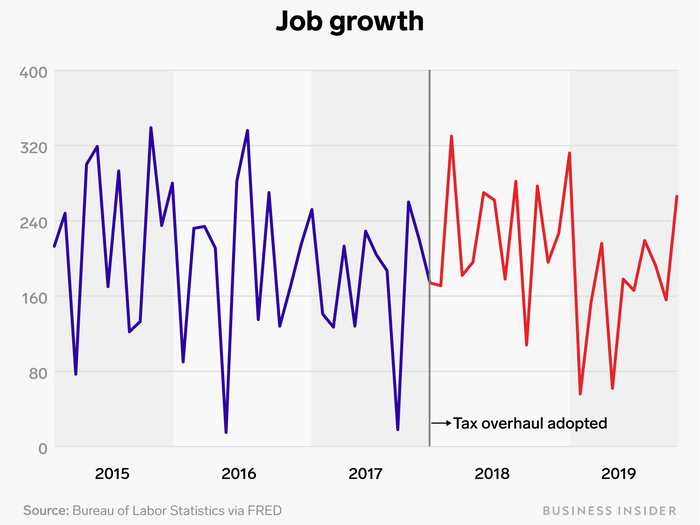
Measuring job growth after the tax cuts provides a mixed picture.
The number of new jobs gained in the immediate months following the cuts were similar in scale to the previous few years. Some corporations like Apple said they would add 20,000 domestic jobs over five years and others such as Walmart increased starting wages and expanded some benefits.
Still, automation and outsourcing continued to hit other industries. Bank of America cut 5,000 jobs in 2018 even as it generated billions in record profits.
Employment remains steady though the economy shows signs of slowing down. But studies suggest the tax cuts had a limited impact promoting job growth.
The National Association of Business Economics released a survey earlier this year finding the overwhelming majority of US businesses — or 84% — didn't speed up their hiring or invest more as a result of the Republican tax cuts.
The tax cuts didn't dramatically ramp up what workers earn in an average hour.
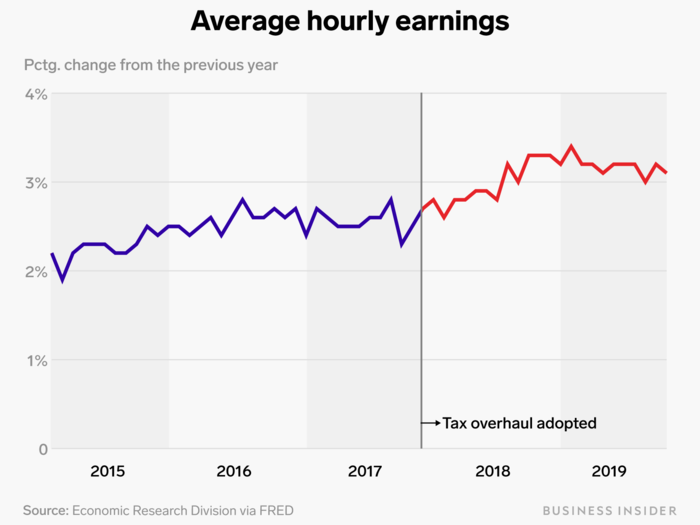
Trump tried championing the law as a boost to the middle class, saying that average household incomes would increase by at least $4,000 a year. Many economists said the promise was very unlikely to pan out, given companies could easily access additional capital cheaply to shore up operations.
The White House later pointed to the rise of average hourly pay as a sign of the law's success.
But it hasn't edged substantially upward since December 2017, hovering between 2.8% and 3.6% up until now.
One estimate from Macroeconomic Advisors, an economic research firm, found that average hourly growth would have to reach 7.8% this year to reach the $4,000 income boost for US households. It only stood over 3.3%, the firm said.
Consumer confidence fluctuated through 2019 — and the tax cuts had little to do with it.
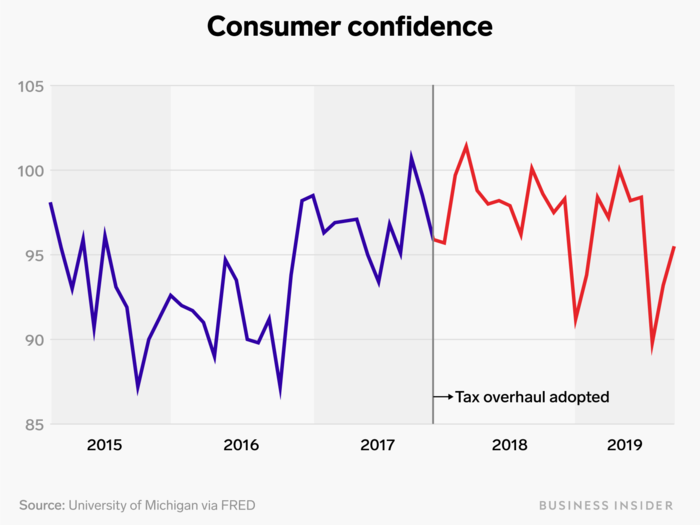
Consumer confidence has fluctuated alongside the country's economic performance over the last two years, edging upward in early 2018. The Republican tax cuts, though, have polled poorly with the public since then.
The majority of taxpayers did receive a cut, though it was very small and surveys showed most Americans didn't notice it in their take-home pay or tax bills. That suggests the law had a limited impact shaping voter's views on the health of the economy.
Other factors, like global trade war fears, have weighed more on US consumers recently.
The University of Michigan consumer confidence survey's chief economist told the Wall Street Journal earlier this year that "the impact of the tax reform legislation on consumer confidence has all but disappeared."
Capital spending has steadily decreased in the last two years, mainly the product of uncertainty of Trump's ongoing trade wars.
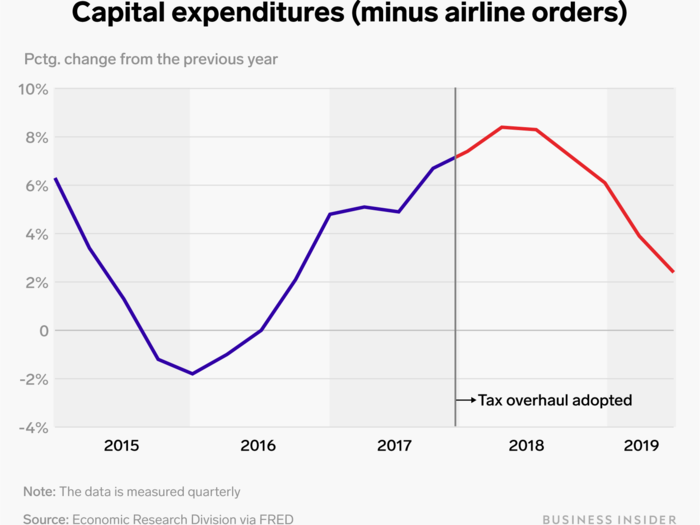
Capital expenditures refers to investments that businesses make in new equipment, buildings, and technology that they use to expand and improve existing operations.
There was an initial jump after the tax bill was passed, but it faded through 2018. It took a hit as lower oil prices and Trump's trade war with China injected uncertainty into the global economy.
The International Monetary Fund found in an analysis of Fortune 500 companies that only 20% of increased revenue was spent on capital expenditures — the other 80% went to investors through buybacks or dividends among other asset adjustments.
Usually, expectations of future growth drive increases in capital spending. The corporate outlook, though, hasn't improved and business investment declined through 2019 as companies wrestle with trade war uncertainty.
The tax cuts didn't reverse the decline in manufacturing activity.
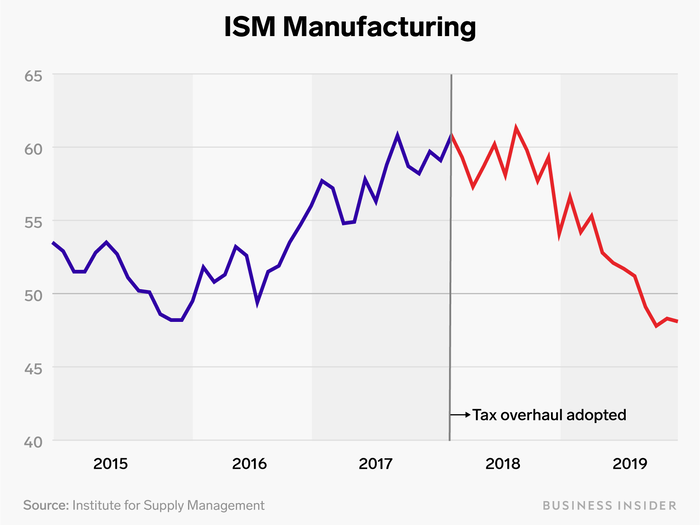
The manufacturing index measures production levels each month and it's considered a key indicator of the US economy's broader health. Readings below 50 indicate a contraction of activity.
While the GOP tax cuts jolted the sector and helped create manufacturing jobs — averaging 20,000 a month in 2018, the highest in three decades — it didn't reverse a downward trend in this index.
Domestic producers suffered a brutal hit with the ongoing trade war with China and slowing global growth. Major corporations like General Motors posted record revenues but continued laying off workers in their factories.
The latest ISM measure for November stood at 48.1, the fourth straight month of a reading below 50 that signals contraction. It reflects continued weakness in new orders and exports.
Stock buybacks, however, set records in 2018, the first full year of the Trump tax law — and they're higher than before the law was enacted.
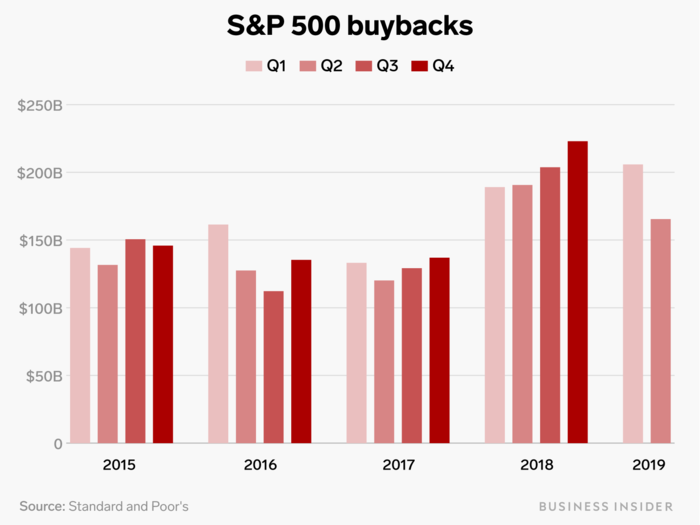
Buybacks reduce the number of shares a company has on the market, which jacks up their stock price to the benefit of stockholders and corporate executives.
Corporations were some of the most enthusiastic supporters of the 2017 tax cuts. And it's easy to see why: they reaped most of the law's rewards.
Last year, the nation's largest 500 companies invested far more into buying back stock than they did to expand operations with their tax savings. Buybacks surpassed a record $1 trillion in 2018, 50% more than the prior year.
In 2019, however, global economic uncertainty pushed the number of buybacks downward. Goldman Sachs estimated that the total amount of buybacks would slide down to $710 billion.
Popular Right Now
Popular Keywords
Advertisement